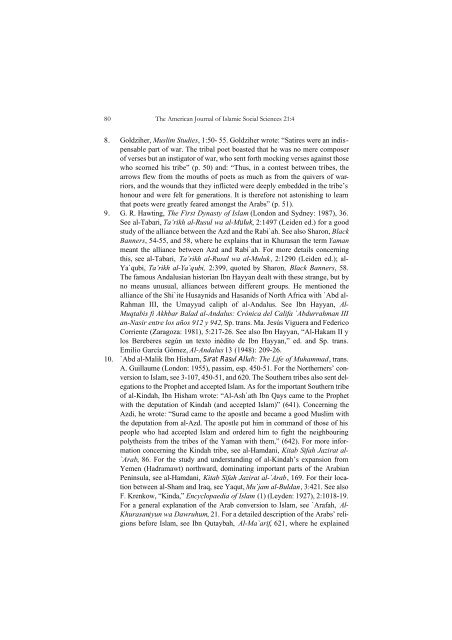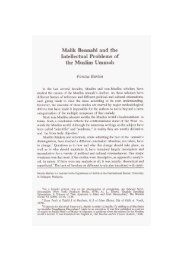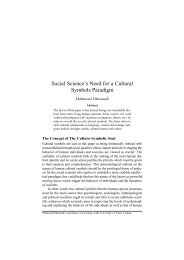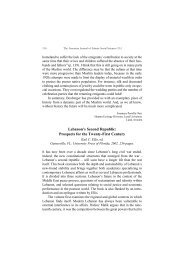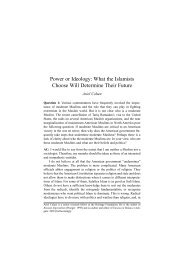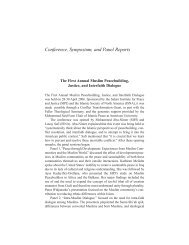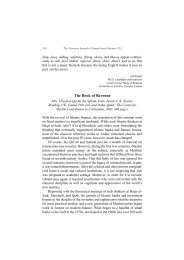Arab Tribes, the Umayyad Dynasty, and the `Abbasid ... - Epistemology
Arab Tribes, the Umayyad Dynasty, and the `Abbasid ... - Epistemology
Arab Tribes, the Umayyad Dynasty, and the `Abbasid ... - Epistemology
Create successful ePaper yourself
Turn your PDF publications into a flip-book with our unique Google optimized e-Paper software.
80 The American Journal of Islamic Social Sciences 21:4<br />
8. Goldziher, Muslim Studies, 1:50- 55. Goldziher wrote: “Satires were an indispensable<br />
part of war. The tribal poet boasted that he was no mere composer<br />
of verses but an instigator of war, who sent forth mocking verses against those<br />
who scorned his tribe” (p. 50) <strong>and</strong>: “Thus, in a contest between tribes, <strong>the</strong><br />
arrows flew from <strong>the</strong> mouths of poets as much as from <strong>the</strong> quivers of warriors,<br />
<strong>and</strong> <strong>the</strong> wounds that <strong>the</strong>y inflicted were deeply embedded in <strong>the</strong> tribe’s<br />
honour <strong>and</strong> were felt for generations. It is <strong>the</strong>refore not astonishing to learn<br />
that poets were greatly feared amongst <strong>the</strong> <strong>Arab</strong>s” (p. 51).<br />
9. G. R. Hawting, The First <strong>Dynasty</strong> of Islam (London <strong>and</strong> Sydney: 1987), 36.<br />
See al-Tabari, Ta’rikh al-Rusul wa al-Muluk, 2:1497 (Leiden ed.) for a good<br />
study of <strong>the</strong> alliance between <strong>the</strong> Azd <strong>and</strong> <strong>the</strong> Rabi`ah. See also Sharon, Black<br />
Banners, 54-55, <strong>and</strong> 58, where he explains that in Khurasan <strong>the</strong> term Yaman<br />
meant <strong>the</strong> alliance between Azd <strong>and</strong> Rabi`ah. For more details concerning<br />
this, see al-Tabari, Ta’rikh al-Rusul wa al-Muluk, 2:1290 (Leiden ed.); al-<br />
Ya`qubi, Ta’rikh al-Ya`qubi, 2:399, quoted by Sharon, Black Banners, 58.<br />
The famous Andalusian historian Ibn Hayyan dealt with <strong>the</strong>se strange, but by<br />
no means unusual, alliances between different groups. He mentioned <strong>the</strong><br />
alliance of <strong>the</strong> Shi`ite Husaynids <strong>and</strong> Hasanids of North Africa with `Abd al-<br />
Rahman III, <strong>the</strong> <strong>Umayyad</strong> caliph of al-Andalus. See Ibn Hayyan, Al-<br />
Muqtabis fi Akhbar Balad al-Andalus: Crónica del Califa `Abdurrahman III<br />
an-Nasir entre los años 912 y 942, Sp. trans. Ma. Jesús Viguera <strong>and</strong> Federico<br />
Corriente (Zaragoza: 1981), 5:217-26. See also Ibn Hayyan, “Al-Hakam II y<br />
los Bereberes según un texto inédito de Ibn Hayyan,” ed. <strong>and</strong> Sp. trans.<br />
Emilio García Gómez, Al-Andalus 13 (1948): 209-26.<br />
10. `Abd al-Malik Ibn Hisham, Sirat Rasul Allah: The Life of Muhammad, trans.<br />
A. Guillaume (London: 1955), passim, esp. 450-51. For <strong>the</strong> Nor<strong>the</strong>rners’ conversion<br />
to Islam, see 3-107, 450-51, <strong>and</strong> 620. The Sou<strong>the</strong>rn tribes also sent delegations<br />
to <strong>the</strong> Prophet <strong>and</strong> accepted Islam. As for <strong>the</strong> important Sou<strong>the</strong>rn tribe<br />
of al-Kindah, Ibn Hisham wrote: “Al-Ash`ath Ibn Qays came to <strong>the</strong> Prophet<br />
with <strong>the</strong> deputation of Kindah (<strong>and</strong> accepted Islam)” (641). Concerning <strong>the</strong><br />
Azdi, he wrote: “Surad came to <strong>the</strong> apostle <strong>and</strong> became a good Muslim with<br />
<strong>the</strong> deputation from al-Azd. The apostle put him in comm<strong>and</strong> of those of his<br />
people who had accepted Islam <strong>and</strong> ordered him to fight <strong>the</strong> neighbouring<br />
poly<strong>the</strong>ists from <strong>the</strong> tribes of <strong>the</strong> Yaman with <strong>the</strong>m,” (642). For more information<br />
concerning <strong>the</strong> Kindah tribe, see al-Hamdani, Kitab Sifah Jazirat al-<br />
`<strong>Arab</strong>, 86. For <strong>the</strong> study <strong>and</strong> underst<strong>and</strong>ing of al-Kindah’s expansion from<br />
Yemen (Hadramawt) northward, dominating important parts of <strong>the</strong> <strong>Arab</strong>ian<br />
Peninsula, see al-Hamdani, Kitab Sifah Jazirat al-`<strong>Arab</strong>, 169. For <strong>the</strong>ir location<br />
between al-Sham <strong>and</strong> Iraq, see Yaqut, Mu`jam al-Buldan, 3:421. See also<br />
F. Krenkow, “Kinda,” Encyclopaedia of Islam (1) (Leyden: 1927), 2:1018-19.<br />
For a general explanation of <strong>the</strong> <strong>Arab</strong> conversion to Islam, see `Arafah, Al-<br />
Khurasaniyun wa Dawruhum, 21. For a detailed description of <strong>the</strong> <strong>Arab</strong>s’ religions<br />
before Islam, see Ibn Qutaybah, Al-Ma`arif, 621, where he explained


